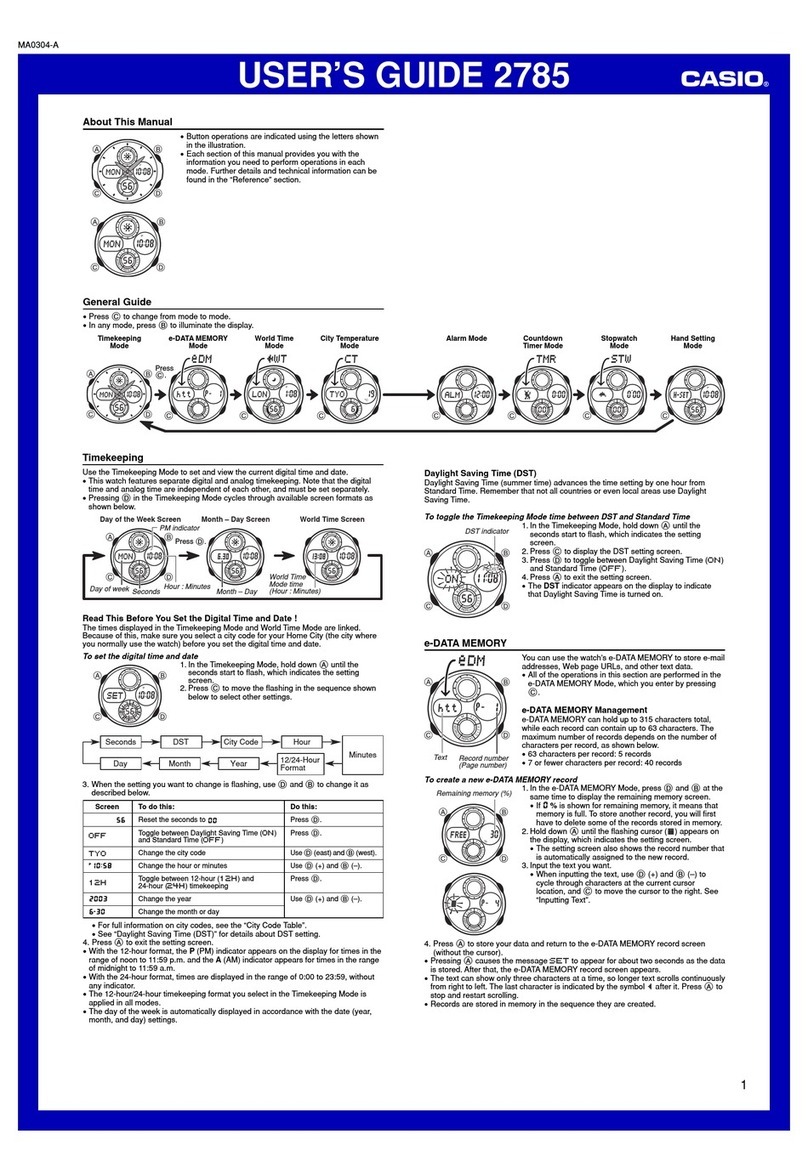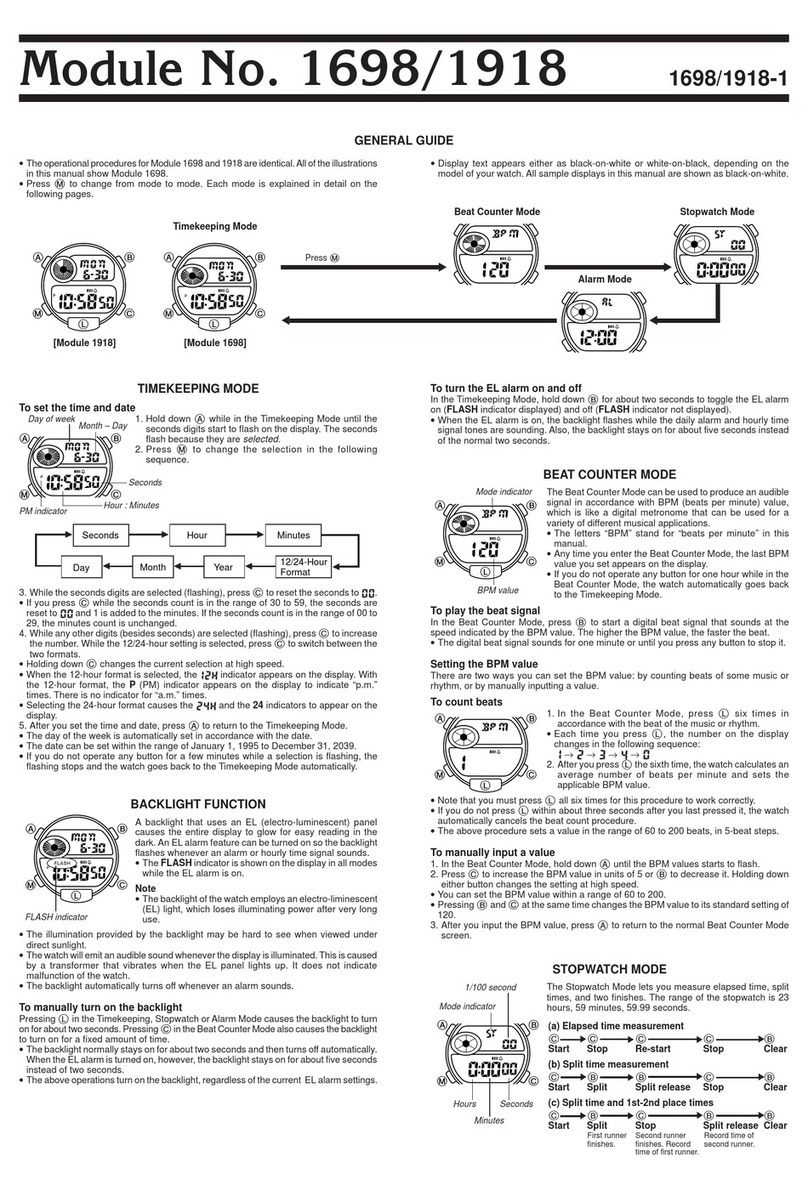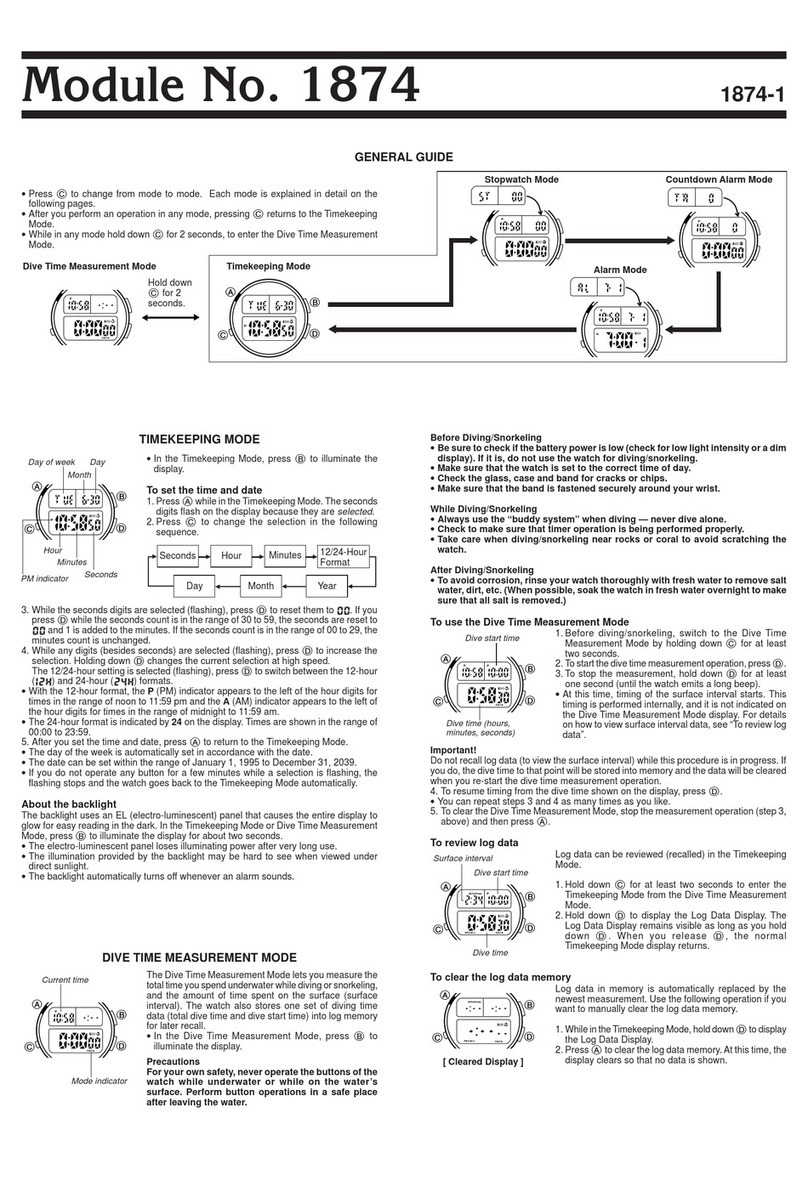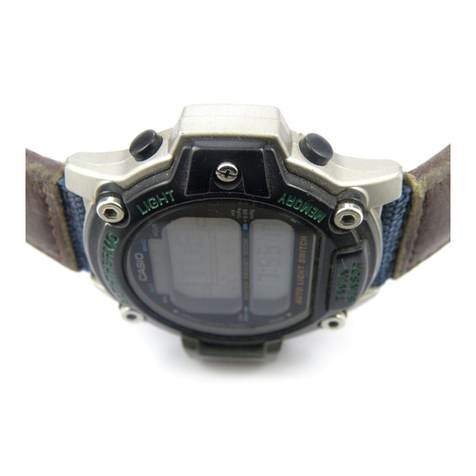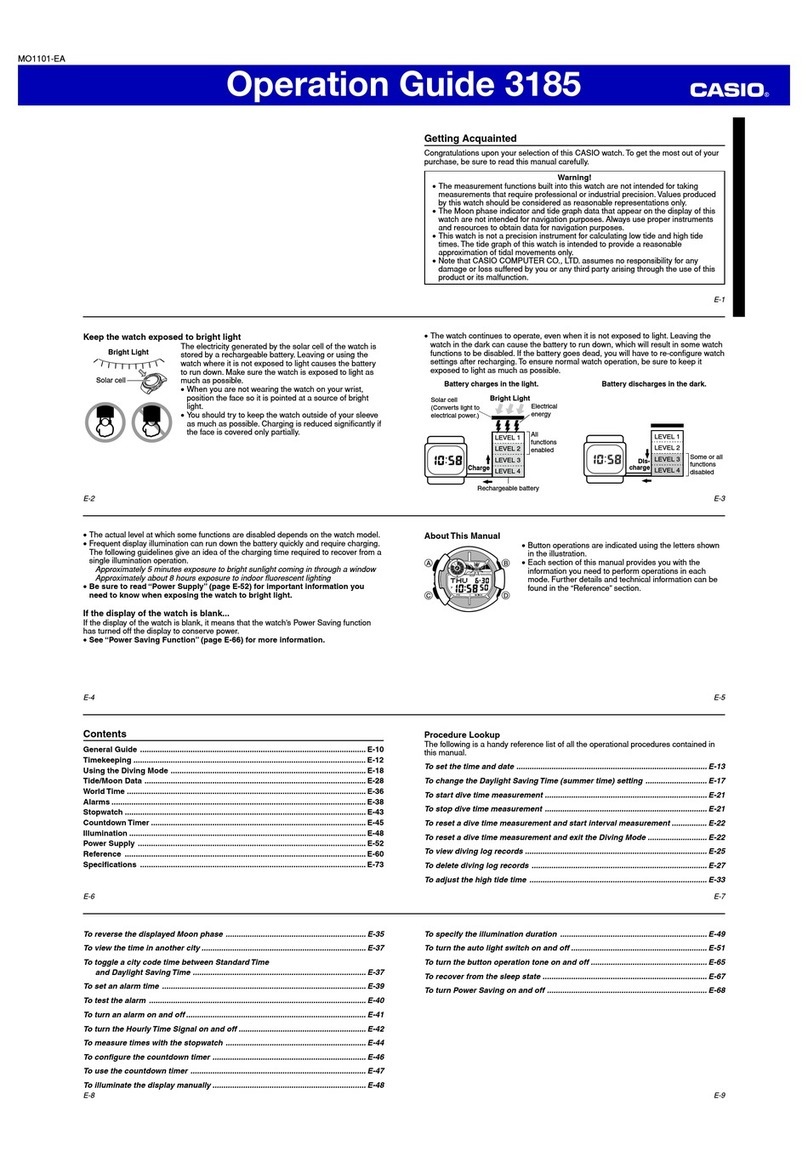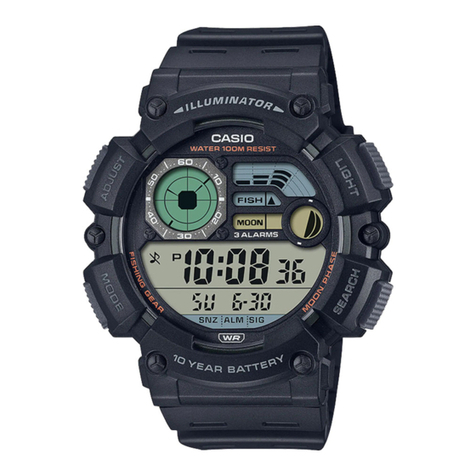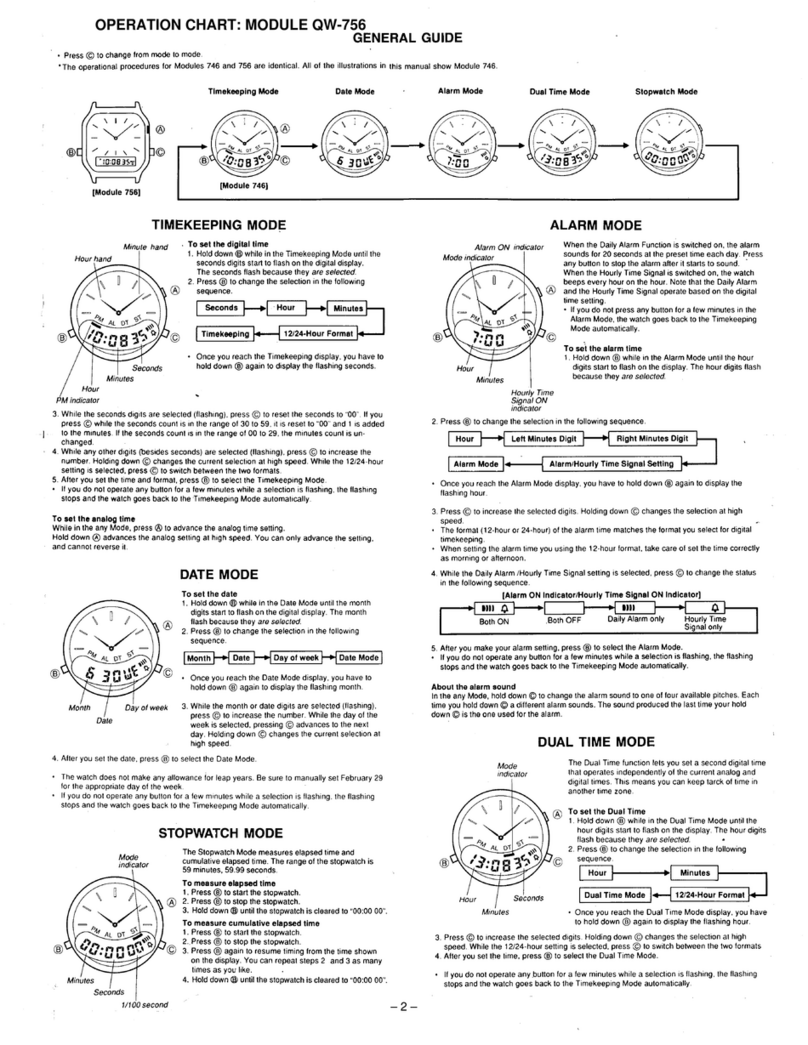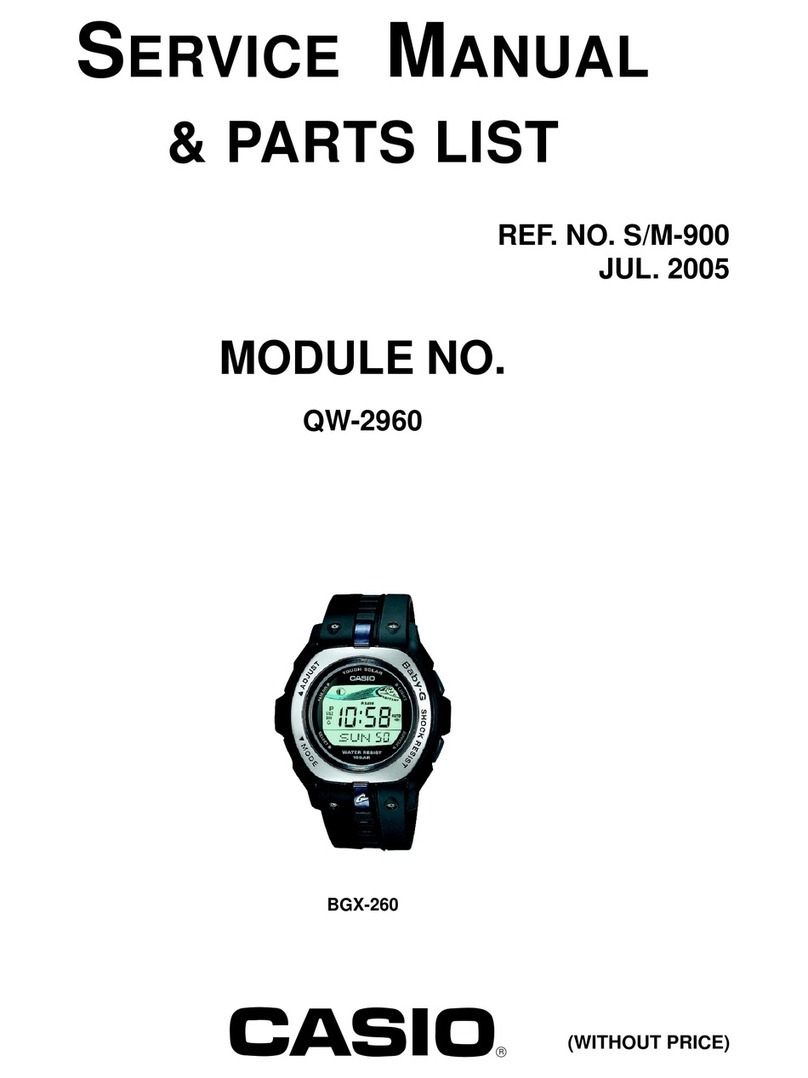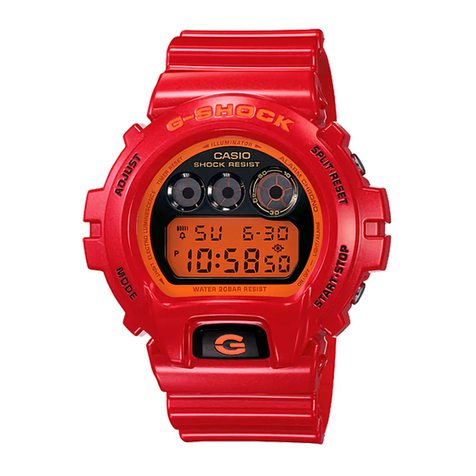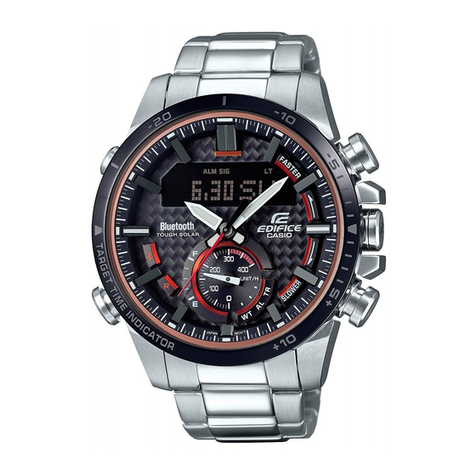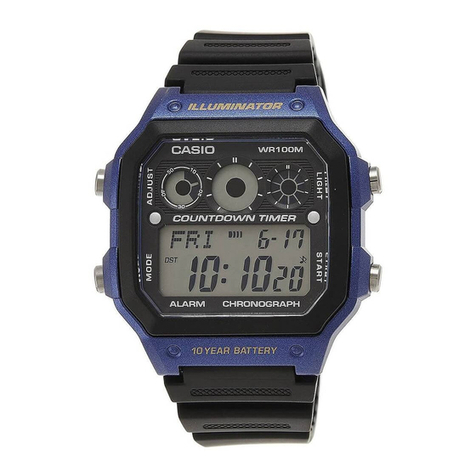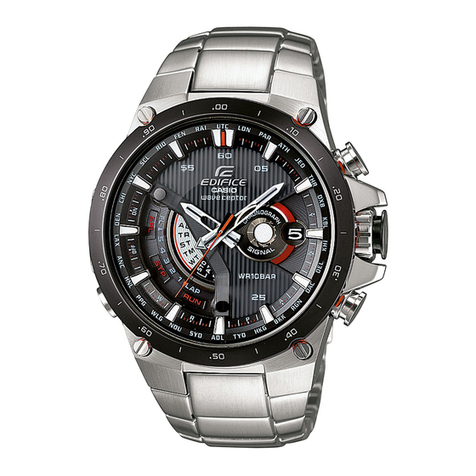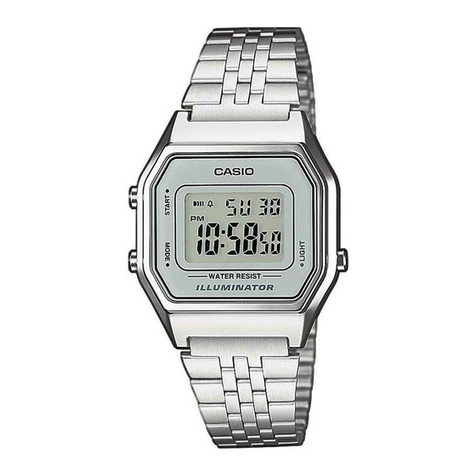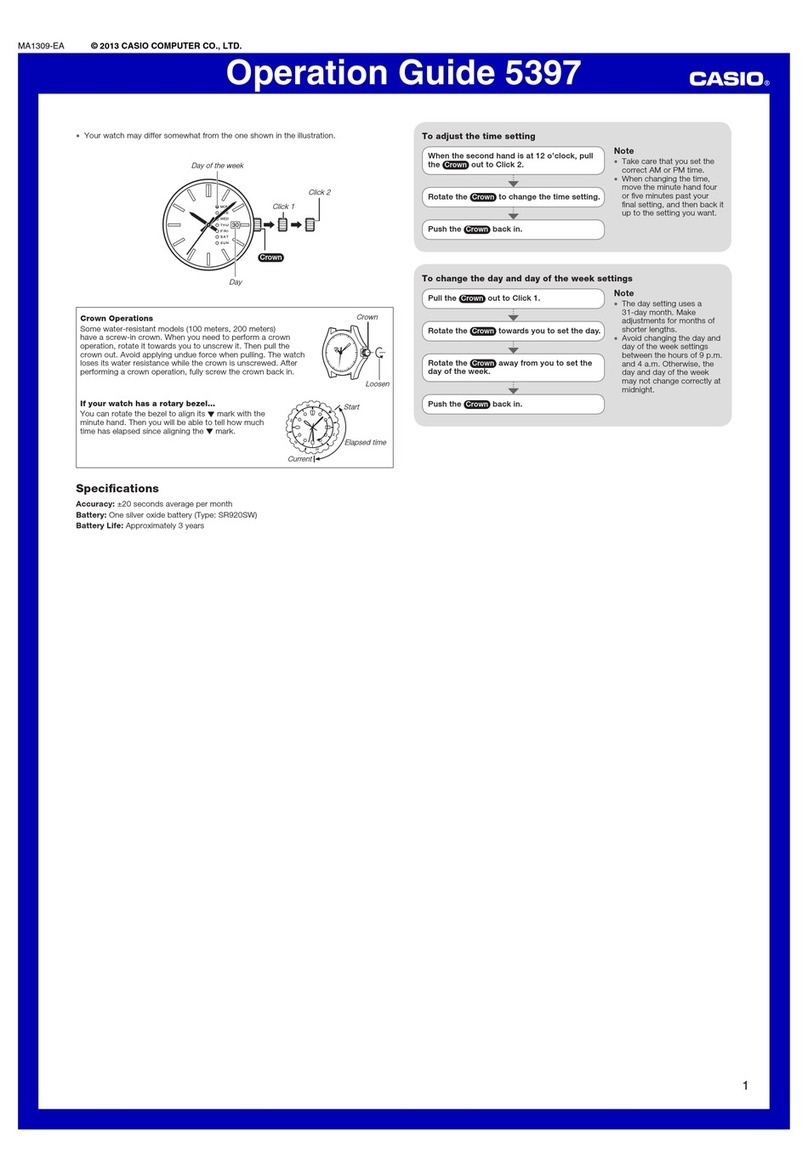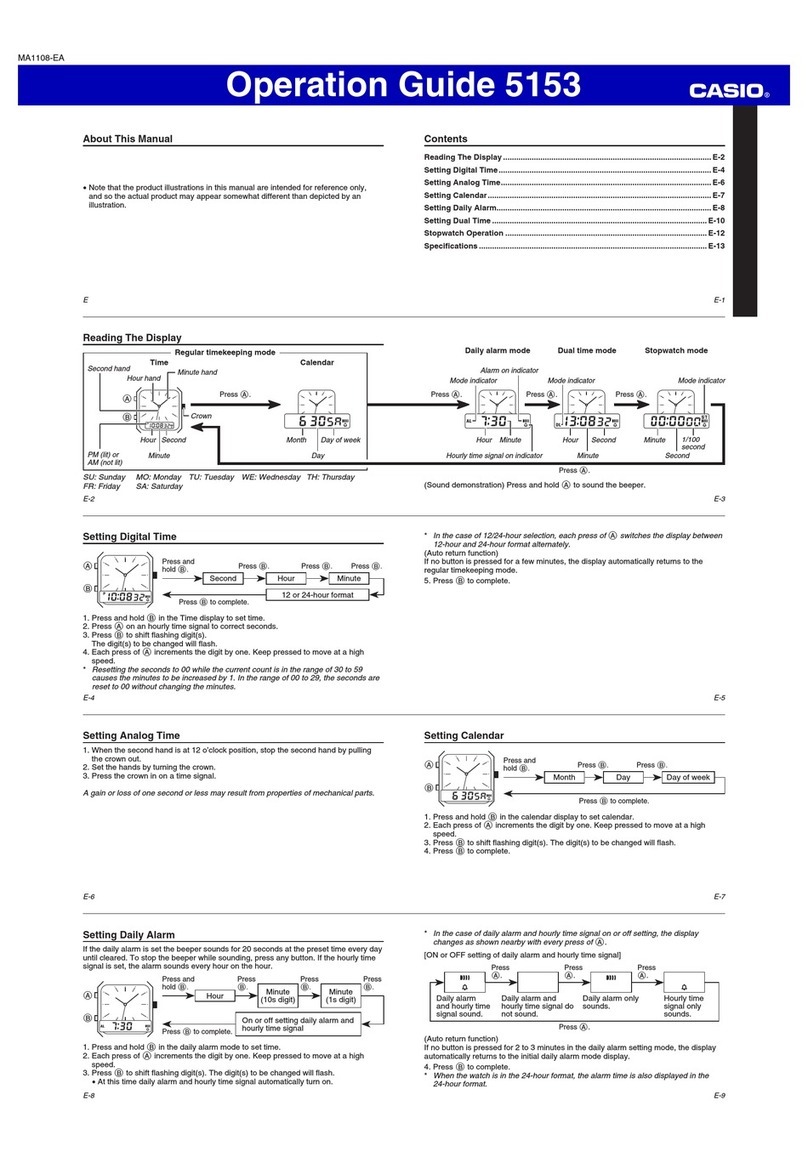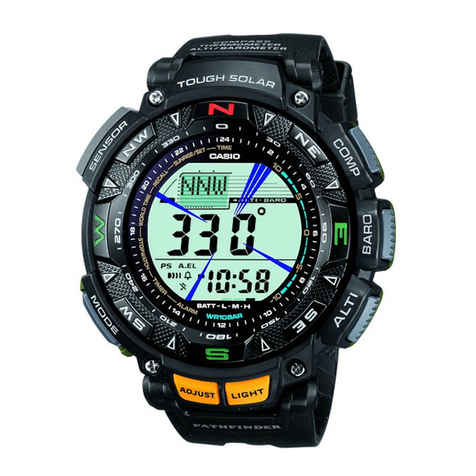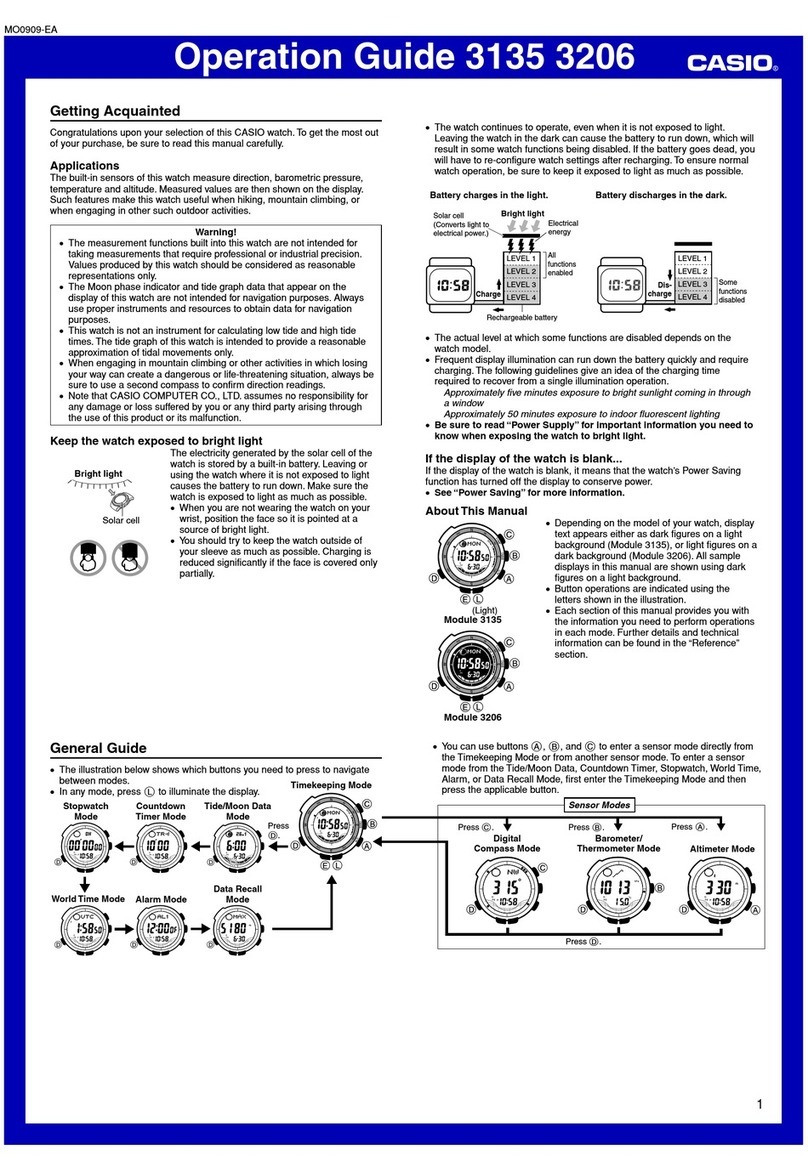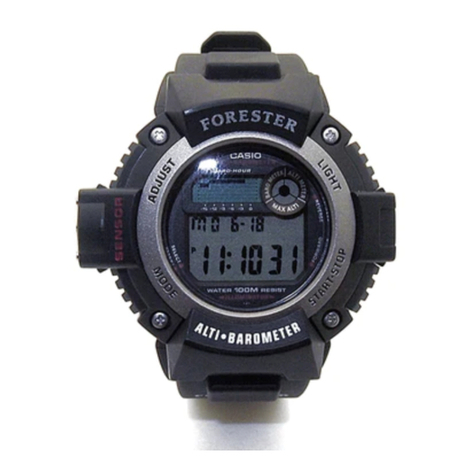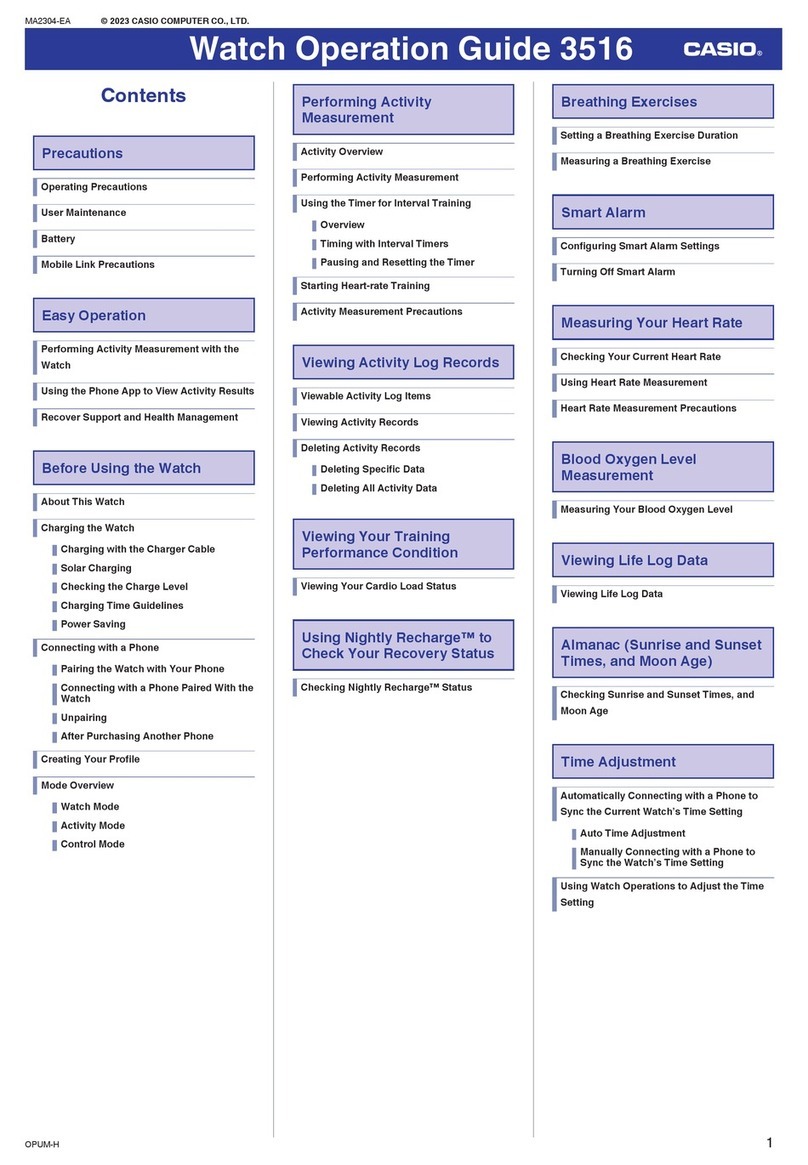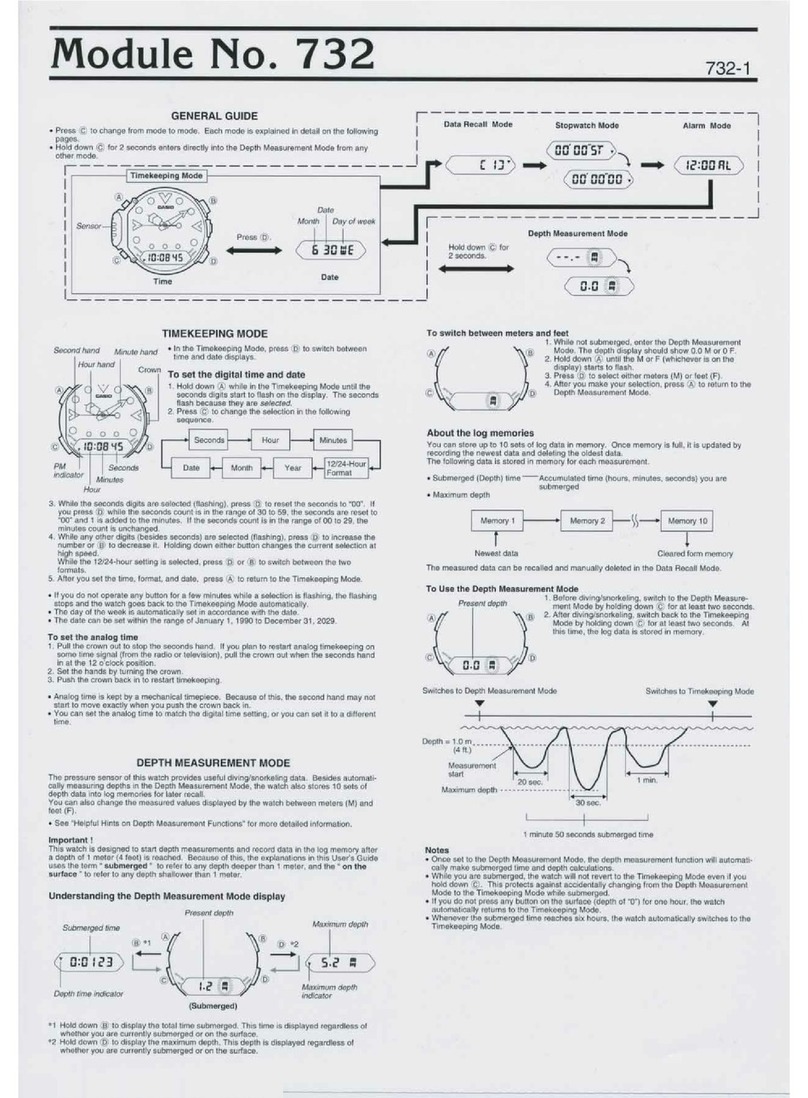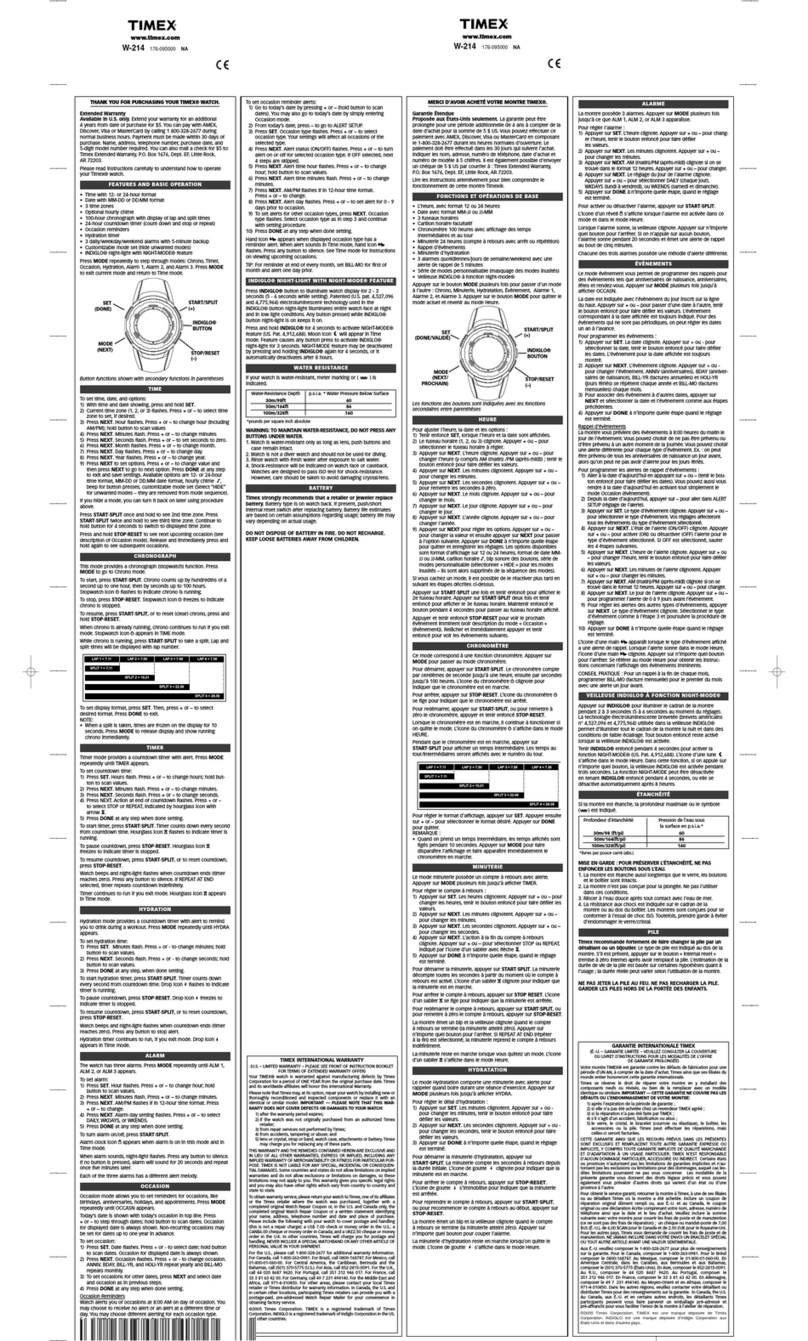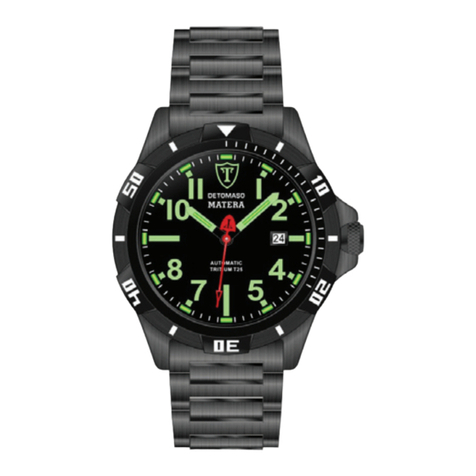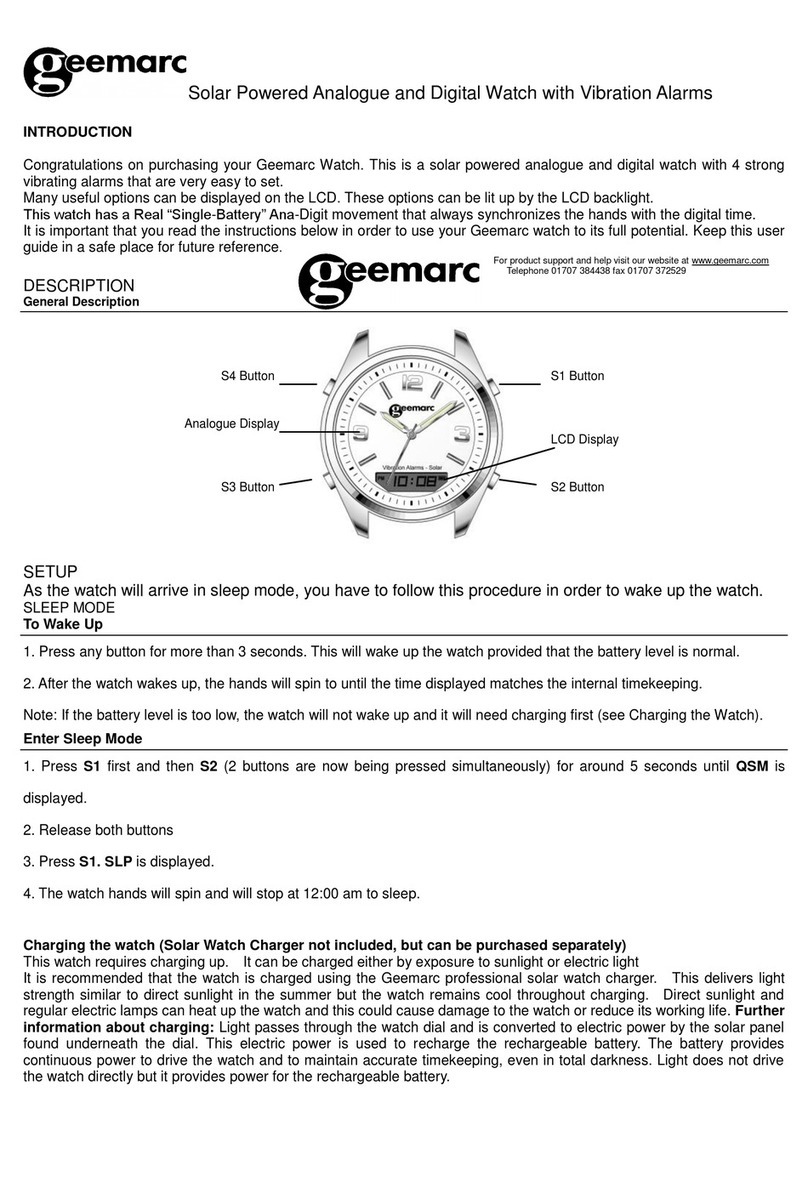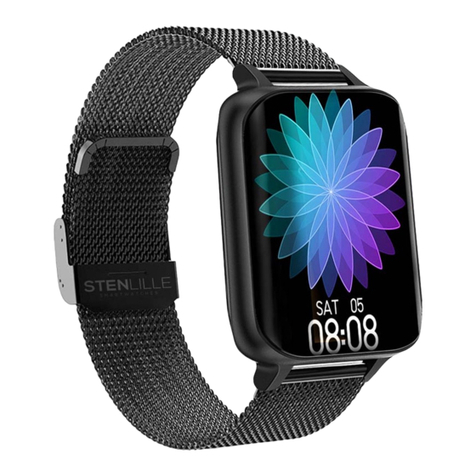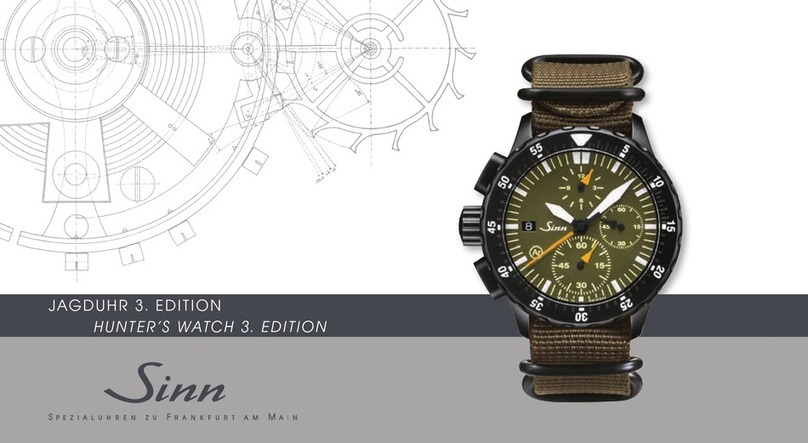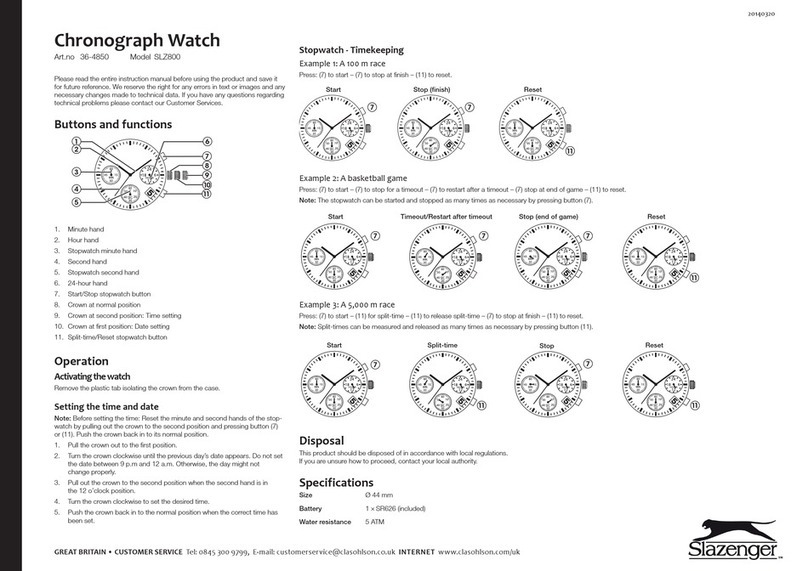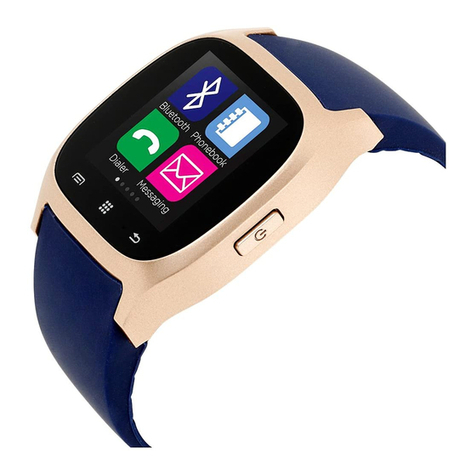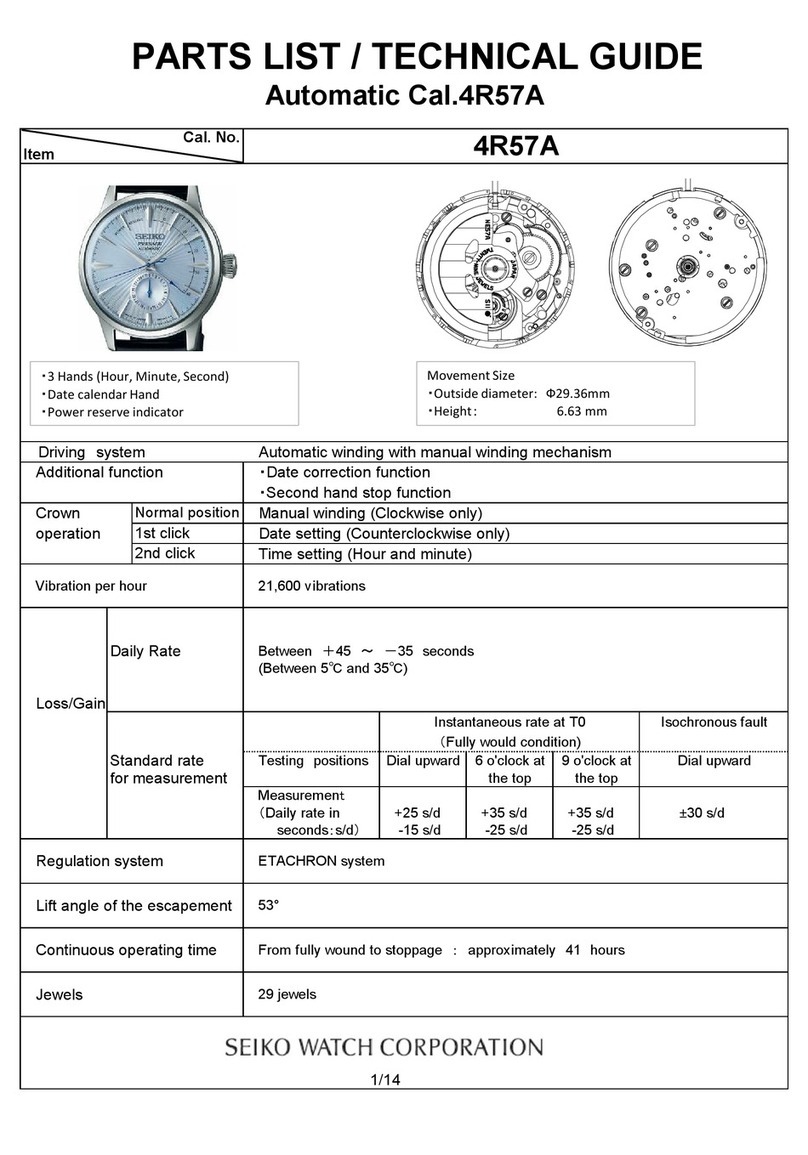
— 3 —
Accurate temperature measurements cannot be achieved while you are wearing the
watch. The following graph illustrated affects of body temperature on actual
temperature.
Temperature
Temperature measured when watch is worn on wrist
40°C
30°C
20°C
10°C
0°C
10°C20°C30°C40°C
Approximate
Differences caused by
individual body
temperture or clothing
MOON DATA MODE
Be sure to set the current time and your current location before trying to use the Moon
Data Mode.
The Moon Data Mode display shows the current moon age, as well as moon up and
moon down times. Moon age is indicated both by a value and one of the following
graphics.
• The moon up time indicates when the moon will
reach its highest point relative to your current
location (upper transit), while the moon down
time indicates when it will reach its lowest point
(lower transit). Note that moon up and moon
down times are accurate up to ±30 minutes.
You can use the key operation below to look up the moon age and the moon up and
T1.Use Cto enter the Moon Data Mode.
• When you enter the Moon Data Mode from
another mode, the display shows the moon up
and moon down times for the current date (as
kept in the Timekeeping Mode).
2.Press Dto advance the date or Bto move
back. Holding down either button changes the
date at high speed.
3.When the date you want is displayed, you will have to wait for about 2 seconds as
the watch performs its internal calculation before displaying the moon up and moon
down time for that date.
TIDE GRAPH MODE
Before using the Tide Graph Mode, be sure to first carefully set the current time, your
current location, and the lunitidal interval.
About the lunitidal interval
The lunitidal interval is the period from the moon's upper transit (moon up) to high
tide. If you know the lunitidal interval, tide changes can be determined using the moon
age. This watch calculates tide changes according to the current time and the location
setting, and displays them graphically.
To calculate the lunitidal interval
1.Look up the high tide time for the flood tide of the location whose tide changes you
want to know.
2.Use this watch to look up the moon up time that occurs immediately before this
time.
3.Subtracting the moon up time from the high tide time produces the lunitidal interval.
To set the lunitidal interval 1.In the Moon Data Mode, hold down Auntil both
sides of the Tide Graph and hour digits start to
flash, as shown below.
• You can also start this procedure by holding
down Awhile in the Tide Graph Mode.
2.Use Cto select the digit whose setting you want
to change. Each press of Cmoves the flashing
to the next digit.
3.Use Dto increase the flashing digit or Bto
decrease it. Holding down either button changes
the setting at high speed.
4.After you are finished making the lunitidal setting you want, press Ato enter the
Tide Graph Mode.
About the Tide Graph Mode
The Tide Graph Mode shows the changing of the tides in graphic form. The graph
uses time (advancing from left to right) as the horizontal axis, and tide change as the
vertical axis.
• You can enter the Tide Graph Mode by pressing Awhile in the Moon Data Mode.
Though you can change the time setting while in the Tide Graph Mode, you cannot
change the month or day setting. To display the tide graph for another date, return to
the Moon Graph Mode, change the date setting, and then enter the Tide Graph
Mode again. Also note that you cannot directly change the month setting in the
Moon Data Mode. The month setting changes automatically as you increase or
decrease the day setting.
• The Tidal Graph is also on the display in the Timekeeping Mode, where it indicates
the tide for the current time.
To display the tide graph for a specific time
1.Use Cto enter the Moon Data Mode.
• When you enter the Moon Data Mode from
another mode, the display shows the moon up
and moon down times for the current date (as
kept in the Timekeeping Mode).
2.Press Ato enter the Tide Graph Mode.
• Whenever you enter the Tide Graph Mode, the
graph shows the tide movements for 6:00 am of
the current date.
3.Press Dto increase the hour or Bto decrease
it. Holding down either button changes the hour
at high speed.
Moon
Location
Earth
Moon Moon-Down
Moon-UP
A
C
B
D
Moon Data Mode Data
High Ebb Low Flood High
A
C
B
D
Flashes
THERMOMETER FUNCTIONS
A built-in temperature sensor measures temperature and shows the measured value
on the display. The readout from the temperature sensor can also be switched
between Celsius (°C) and Fahrenheit (°F). The thermometer can be calibrated to
correct for errors.
Important
Temperature measurements are affected by your body temperature (while you are
wearing the watch), direct sunlight, and moisture. To achieve a more accurate
temperature measurement, remove the watch from your wrist, place it in a well
ventilated location out of direct sunlight, and wipe off all moisture from the case. It
takes approximately 20 to 30 minutes for the case of the watch to reach the actual
surrounding temperature.
About Temperature Measurement
Temperature measurements are taken automatically every two minutes, regardless of
what mode the watch is in. You can see the measured values in the Timekeeping
Mode’s Temperature Display.
Understanding the temperature display
1.Use Cto enter the Timekeeping Mode.
2.Press Dto display the Temperature Display.
• Whenever you switch to the Temperature Display,
the current temperature is measured and
displayed.
* The display shows “ – . – °C (or °F)” if a
measured value falls outside the range of –20°C
to 60°C (–4°F to 140°F). The normal display will
return as soon as the temperature returns within
the allowable range.
1.While in the Timekeeping Mode, press Dto
display the Temperature Display.
2.Holding down Aand the current temperature
digits flash.
3.Press Cto select either Celsius “°C” or
Fahrenheit “°F”.
4.After you select the Celsius or Fahrenheit, press
Ato return to the Temperature Display.
Calibrating the Temperature Measurement
The temperature sensor of this watch is calibrated at the factory before shipment and
further adjustment is normally not required. If noticeable error is found in the
temperature readings produced by the watch, you can adjust it to correct the error.
Important
Incorrectly calibrating the temperature measurement of this watch can result in
incorrect readings. Carefully read the following before doing anything.
• Compare the readings produced by the watch with those of another reliable,
accurate thermometer.
• If calibration is required, remove the watch from your wrist and wait for 20 or 30
minutes to give the temperature of the watch time to stabilize.
• Perform the temperature calibration before procedure as quickly as possible to avoid
the temperature of the watch being affected by your body temperature.
• You can also preform temperature calibration underwater, if the water temperature is
stable.
T1.Use Cto enter the Timekeeping Mode and
press Dto display the Temperature Display.
2.Holding down Aand the current temperature
digits flash.
3.Each press of Dincrease the displayed
temperature by 0.1°C, and pressing the B
decrease it by 0.1°C.
• If you have selected Fahrenheit as your unit of
measurement, the above operations change the
reading by 0.2°F.
• You can calibrate the temperature within a range
of –9.9°C to +9.9°C (–18.0°F to +18.0°F).
• Press Band Dat the same time to rest the
temperature calibration to the factory setting.
4.After calibrating the temperature, press Ato
return to the Temperature Display.
A
C
B
D
Current
temperature
*
A
C
B
D
Flashes
A
C
B
D
Flashes
A
C
B
D
Back
Forward
Moon time date search
A
C
B
D
Flashes
New Moon Crescent
Moon
Half Moon
First Quarter
Full Moon
Half Moon
Last Quarter
Switching between Celsius and Fahrenheit
o calibrate the temperature
o display the moon up and moon down time for a specific date
moon down times for any date from January 1, 1995 to December 31, 2039.
